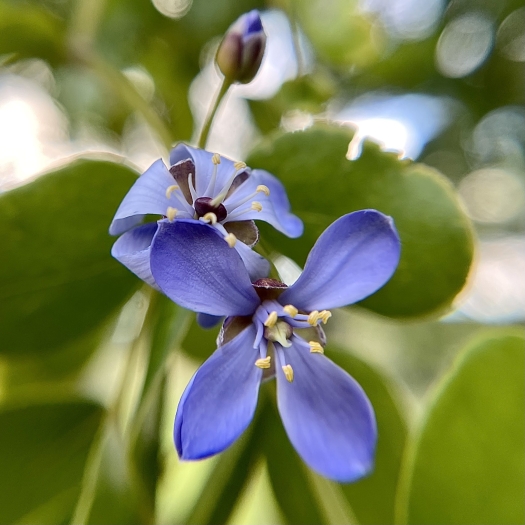Roughbark Lignum-Vitae
(Guaiacum officinale)
Roughbark Lignum-Vitae (Guaiacum officinale)
/
/

© Tara Severns
CC BY 4.0
Image By:
© Tara Severns
Recorded By:
Copyright:
CC BY 4.0
Copyright Notice:
Photo by: © Tara Severns | License Type: CC BY 4.0 | License URL: http://creativecommons.org/licenses/by/4.0/ | Uploader: taraseverns | Publisher: iNaturalist |




















Estimated Native Range
Summary
Guaiacum officinale, commonly known as Roughbark Lignum-vitae or Guaiacwood, is a slow-growing evergreen tree native to the dry subtropical woodlands and coastal areas of the Caribbean and northern South America. It typically reaches up to 33 feet (10 meters) in height and has a dense, spreading crown. The tree is notable for its attractive compound leaves, showy blue flowers that bloom intermittently throughout the year, and bright-yellow-orange fruits that follow the flowering period. The bark is deeply furrowed, adding to its ornamental value. Guaiacwood is highly valued for its extremely hard and dense wood, which has been historically used for shipbuilding and making bearings. Its medicinal properties, particularly the resin known as guaiac, have been recognized for centuries, with applications in diagnosing medical conditions such as blood in stool.
In cultivation, Guaiacum officinale is appreciated for its beauty and durability, often used in xeriscaping and as a specimen tree in tropical and subtropical gardens. It requires well-drained soil, tolerates drought, and thrives in full sun to part shade. Due to its slow growth rate and endangered status, it is not commonly available in the nursery trade, and gardeners are encouraged to seek out sustainably sourced plants. Its conservation status has led to restrictions on trade under CITES Appendix II, and it should not be harvested from the wild.CC BY-SA 4.0
In cultivation, Guaiacum officinale is appreciated for its beauty and durability, often used in xeriscaping and as a specimen tree in tropical and subtropical gardens. It requires well-drained soil, tolerates drought, and thrives in full sun to part shade. Due to its slow growth rate and endangered status, it is not commonly available in the nursery trade, and gardeners are encouraged to seek out sustainably sourced plants. Its conservation status has led to restrictions on trade under CITES Appendix II, and it should not be harvested from the wild.CC BY-SA 4.0
Plant Description
- Plant Type: Shrub, Tree
- Height: 10-30 feet
- Width: 8-11 feet
- Growth Rate: Slow
- Flower Color: Blue
- Flowering Season: Spring, Summer, Fall
- Leaf Retention: Evergreen
Growth Requirements
- Sun: Full Sun, Part Shade
- Water: Low, Medium
- Drainage: Fast, Medium
Common Uses
Bee Garden, Drought Tolerant, Low Maintenance, Salt Tolerant, Showy Flowers
Natural Habitat
Native to dry subtropical woodlands and coastal areas of the Caribbean and northern South America
Other Names
Common Names: Lignum Vitae , Tree of Life , Guayacan , guaiacwood , Pockholz , Guaiacum , Common Lignum Vitae , Commoner Lignum Vitae , Guaiac Tree , Bois Saint
Scientific Names: Guaiacum officinale , Guaiacum bijugum , Guaiacum breynii , Guajacum officinale
GBIF Accepted Name: